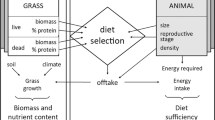ABSTRACT
Selective foraging by large mammals can change ecosystem properties such as plant species composition, nutrient cycling rates, and soil fertility. These changes, in turn, alter the availability of forage and could affect the relative efficiencies of foraging strategies used by these animals. We used a simulation model to predict how alternate foraging strategies affected the net annual energy balance of moose (Alces alces), moose density, and distribution of browse across the landscape. The model simulates the spatial distribution of vegetation in an 8-ha landscape of 1-m2 cells with seasonal changes in the energetic needs of free-ranging moose and plant phenology. The energetics model was integrated with a moose population model and a plant-growth model for long-term simulations. Changes in bite density in each feeding station are predicted with height and biomass logistic curves modified by a quadratic response to browsing. We tested foraging strategies using random, fractional, and marginal value theorem (MVT) algorithms on landscapes with a range of bite densities and differing spatial distributions. Small-scale disturbances (that is, tree-fall gaps) were required to maintain browse supply and prevent moose population extinction under all foraging strategies. Populations using a fractional stopping rule survived the 100-year simulations because moose browsed across much of the landscape and did not overbrowse patches with high bite density. Populations using random and MVT stopping rules became extinct in about 25 and about 50 years, respectively. Moose using a random stopping rule were in negative energy balance because travel time was high and the net energy intake rate was low on an annual basis. Moose using the MVT stopping rule were initially in positive energy balance, but as the high-density browse patches were overbrowsed and low-density unbrowsed patches grew out of reach, bite density decreased, and energy balance became negative in subsequent years. Thus, the foraging strategy used by individual moose resulted in creation of landscapes that strongly affected browse density, browse distribution, moose population density, and moose survival.
Similar content being viewed by others
Author information
Authors and Affiliations
Additional information
Received 30 April 1997; accepted 5 August 1997.
Rights and permissions
About this article
Cite this article
Moen, R., Cohen, Y. & Pastor, J. Linking Moose Population and Plant Growth Models with a Moose Energetics Model. Ecosystems 1, 52–63 (1998). https://doi.org/10.1007/s100219900005
Issue Date:
DOI: https://doi.org/10.1007/s100219900005




